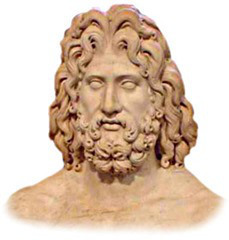Donald J. Robertson's Blog, page 80
February 27, 2013
Script for a Stoic Mindfulness Exercise
Script for Audio Recording of Mindfulness-Based Stoic Exercise
 Text copyright © Donald Robertson, 2012-2013. All rights reserved. Image incorporates Stoic jewellery depicting Zeno of Citium, from photo copyright © Trustees of the British Museum.
Text copyright © Donald Robertson, 2012-2013. All rights reserved. Image incorporates Stoic jewellery depicting Zeno of Citium, from photo copyright © Trustees of the British Museum.
[This is a draft, still being edited and updated. I’ve put it up so that others can provide feedback. It’s a mindfulness-based CBT exercise, involving imaginal exposure, that I’ve modified so that centres on the use of Stoic dogmas, based on the classical exercise called praemeditatio malorum. Stoicism is a complex system, however the Enchiridion of Epictetus provides simplified guidance on psychological exercises, which he specifically describes as being for use in the first instance, presumably by novices. So the Stoic maxims employed here are based as closely as possible on my reading of the original Greek Enchiridion, although they need to be phrased slightly differently for our purposes here, of course.]
[Induction]
Make yourself comfortable, close your eyes, and allow yourself to pause for a while and become more mindful, self-aware, and centred in the present moment… Take time to settle down and get comfortable before we begin. Take time to notice how you’re actually using your body and your mind, right now, in the present moment… Your goal in this exercise is to learn to face troubling situations patiently in your imagination, rehearsing and strengthening a Stoic or “philosophical” attitude toward seeming adversities… You’re going to do so longer and more carefully than normal to develop greater mindfulness, or awareness of the role of your own thoughts and judgements… viewing them with calm, rational, detachment… You’re not trying to control or eliminate any of your feelings but simply to stay with them for a while, letting go of any struggle against them. You may find by doing this exercise that anger, anxiety or other unpleasant feelings tend to reduce naturally over time, but that’s not your immediate purpose. Rather, your goal here is to learn how to observe your own thoughts and separate them from external events…
For now, with your eyes still closed, just be aware of what you’re currently experiencing, from moment to moment, without evaluating it, analysing it, or interpreting it any further… If your mind wanders, that’s fine, just acknowledge the fact and bring your awareness patiently back to the exercise you’re doing… You’re going to choose a scene to picture throughout this exercise… You can start by working through a mildly upsetting event and then progressively working on more challenging ones… So pick a situation to imagine yourself in right now, if you haven’t already… Employing all of your senses, as if it’s actually happening right now, and you’re seeing things through your own eyes… Make it as realistic as possible and pay close attention to the most upsetting parts of the scene rather than trying to avoid them… Turn it into a brief sequence of events, like a video clip, and imagine going through it as realistically as possible… Beginning… middle… and end… Don’t try to change anything… Just observe things in a detached way and allow yourself to accept and fully experience your internal reactions so that any novelty or surprise gradually wears off and events begin to seem more and more familiar as you get used to contemplating them…
Keep imagining yourself in that situation, right now… but throughout this exercise, also have the following advice from the ancient Stoics constantly in mind… “People are not upset by events but by their opinions about events”, especially their value-judgements… Keep reminding yourself, as you picture that scene before you… There are many alternative ways to view external events and so different people feel differently about them… Your attitude toward events is the most important thing in life rather than the events themselves… Keep guard constantly, therefore, over your judgements and intentions, and watch them closely. When automatic thoughts or feelings cross your mind, you always have the freedom to suspend your response… withholding your agreement from your initial impressions, rather than allowing yourself to be carried away by them… so pause for a moment and observe your thoughts… Say to yourself in response to them: “You are just an impression, a mental representation, and not at all the thing you claim to represent.” Observe the events in your mind, taking a step back from your impressions rather than going along with them and thinking about what follows next… Instead, silently examine whether they’re about things that are “up to you”, under your direct control, or not… This is a fundamental precept of Stoicism: That only things that are “up to us” are intrinsically good or bad, and that bodily and external things are “indifferent” with regard to our ultimate wellbeing… neither helping nor harming our character in themselves, but only through the use we make of them…
[Repeated Premeditation of Adversity]
Now you’re going to review that whole sequence of events very patiently, a few more times, from beginning to end… Start at the beginning now… going through things slowly and with mindfulness… Remind yourself that it’s not events that upset you but your opinions about events, especially your value judgements… So don’t try to change anything… Instead, as you go through events, practice taking a step back from your thoughts and actively accepting your feelings as harmless and indifferent… As you continue to go through those events slowly, allow your mind to become more absorbed in the scene, using your senses, as if it’s happening right now… Notice what you see… Notice any sounds you hear… Notice what you’re saying or doing, and how you experience that… Notice any thoughts, images, or associations that go through your mind… Notice your feelings and the sensations in your body… Just allow yourself to acknowledge each experience as it arises… not trying to get rid of or change anything… Patiently going through the whole event, using all of your senses, as if it’s happening right now… Stay with your feelings for a while, as if you’re creating a space around them, giving them the freedom to come and go naturally… Now gradually draw the scene to a close in your mind, and rate the level of discomfort you felt… From 0-100% how distressing was it to imagine? Just make a mental note of that number. [Pause]
Okay, now patiently go through the whole experience once again… from just before you noticed the earliest signs… through the peak or middle… to the end, once the scene is over… Remind yourself: it’s not events that upset you but your opinions and value-judgements about events… Again, patiently watching your thoughts from a distance… while you radically accept your feelings… Don’t try to change anything; don’t try to stop anything from changing… Just take your time… Notice any sounds you hear… Notice what you’re saying or doing, and how you experience that… Notice any thoughts, images, or impressions that go through your mind… Notice your feelings and the sensations in your body… Just allow yourself to acknowledge each experience as it arises… Notice your automatic thoughts and feelings but don’t allow yourself to be carried away by them, pause and take a step back from them instead… Patiently going through the whole event, using all of your senses, as if it’s happening right now… [Pause] Now gradually draw the scene to a close… Make a mental note of your how distressing it was this time, from 0-100%. [Pause]
You will probably find it helpful to repeat this exercise daily, reviewing the same situation in detail in your imagination, 3-4 times, and visualising things more vividly and for longer than you normally would… You can use this time as an opportunity to practice both distancing from your thoughts and actively accepting your feelings… It will probably help if you carefully observe and note down what effect the exercise has upon your problem, both immediately and over time… As your distress reduces, and you begin to feel more confident, you can also consider how you might solve problems and cope differently with similar situations in the future… However, the most important thing for a Stoic is to calmly evaluate whether the thoughts and feelings that you experience in response to apparent “adversity” refer to things that are “up to” you or not. If they’re about external things, the Stoic practice is to remind yourself that these are neither good nor bad, but ultimately indifferent with regard to your moral character and wellbeing. Over time, begin to ask yourself how a perfectly wise and just person, with complete self-control, would respond when faced with the same situation you’re imagining. What would the Stoic Sage do under these circumstances? Let that be your role-model and guide in this and similar situations…
[Emerging]
Now let go even of the scene you were imagining… and gradually begin to expand your awareness throughout your whole body… and into your current environment… Continue to be aware of your breathing and any internal experiences that you’ve been attending to but, in addition, allow your awareness to begin spreading through the rest of your body… throughout the trunk of your body… your arms… your legs… your neck and head… your hands… your feet… your face and eyes… Become aware of your whole body as one… Now gradually spread your awareness out further beyond your body and into the environment around you, where you are and what you’re doing right now, in the real world… Continue to notice how you’re using your body and mind as you slowly open your eyelids and look around you… As you finish the exercise and begin interacting with the external world or other people, continue to be mindful of the way you’re using your body and your mind… and aware of how you relate to environment and any tasks at hand… becoming more focused on the real world around you and the way you’re interacting with life, right now, in the present moment, as you move forward into action…
Filed under: Stoicism Tagged: meditation, mindfulness, Stoic philosophy, stoicism








Some Comments on Stoicism & Cynicism
 Diogenes Laertius says in the prologue of his Lives of Eminent Philosophers that there were two main philosophical lineages: the Ionian, starting with Anaximander, and the Italian, starting with Pythagoras. He then adds:
Diogenes Laertius says in the prologue of his Lives of Eminent Philosophers that there were two main philosophical lineages: the Ionian, starting with Anaximander, and the Italian, starting with Pythagoras. He then adds:
There is another which ends with Chrysippus, that is to say by passing from Socrates to Antisthenes, then to Diogenes the Cynic, Crates of Thebes, Zeno of Citium, Cleanthes, Chrysippus.
This seems to mean that he sees Stoicism as a development of Cynicism, and in some sense derived from Socrates himself; or he may mean that Stoicism can be traced back beyond Socrates to Anaximander and the Ionian tradition. He actually seems to describe the Ionian tradition as splitting into three roughly parallel lineages, founded by Plato, Antisthenes and Aristotle respectively. These correspond to the major Hellenistic schools of the Academy, the Cynic-Stoic tradition, and Aristotelianism, with the addition of the Epicurean school, which he claims follows the Italian succession.
However, preceding his comments about the Cynic-Stoic succession, he explains that although Socrates stood in the Ionian tradition, he “introduced ethics or moral philosophy” , which may suggest that the lineage Socrates-Cynicism-Stoicism originates in Socrates’ novel conception of moral philosophy. It may be worth noting that Diogenes says in his chapter on Socrates that “he discussed moral questions in the workshops and the market-place, being convinced that the study of nature is no concern of ours; and that he claimed that his inquiries embraced ‘Whatso’er is good or evil in an house’”, quoting Homer. This appears to mean that Socrates was particularly known for his concern with moral questions that, rather than being purely abstract, dealt with our daily problems of living. Moreover, Diogenes adds:
In my opinion Socrates discoursed on physics as well as on ethics, since he holds some conversations about providence, even according to Xenophon, who, however, declares that he only discussed ethics. But Plato, after mentioning Anaxagoras and certain other physicists in the Apology,treats for his own part themes which Socrates disowned, although he puts everything into the mouth of Socrates.
This ambivalence about questions of abstract physics can certainly be found in the Stoics as well, despite the fact that their philosophical curriculum was famously divided into: Physics, Ethics and Logic. Later, in his chapter on Antisthenes, Diogenes goes on to mention Zeno and the Stoics:
It would seem that the most manly section of the Stoic School owed its origin to him. Hence Athenaeus the epigrammatist writes thus of them:
“Ye experts in Stoic story, ye who commit to sacred pages most excellent doctrines–that virtue alone is the good of the soul: for virtue alone saves man’s life and cities. But that Muse that is one of the daughters of Memory approves the pampering of the flesh, which other men have chosen for their aim.”
Antisthenes gave the impulse to the indifference of Diogenes, the continence of Crates, and the patient endurance of Zeno, himself laying the foundations of their state.
He concludes this chapter by saying “we will now append an account of the Cynics and Stoics who derive from Antisthenes”. Subsequently, in the last of his chapters on Cynicism (Menedemus) he comments:
They hold further that “Life according to Virtue” is the End to be sought, as Antisthenes says in his Heracles : exactly like the Stoics. For indeed there is a certain close relationship between the two schools. Hence it has been said that Cynicism is a short cut to virtue ; and after the same pattern did Zeno of Citium live his life.
Filed under: Stoicism Tagged: Cynicism, Cynics, philosophy, stoicism, Stoics








February 24, 2013
Marcus Aurelius on Overcoming Anger and Developing Empathy
Stoic Exercises for Overcoming Anger & Developing Empathy
 Copyright © Donald Robertson, 2010-2013. All rights reserved.
Copyright © Donald Robertson, 2010-2013. All rights reserved.
Men have come into being for one another; so either educate them or put up with them. (Meditations, 8.59)
Here are my attempts to (partially) retranslate, from ancient Greek into more contemporary English, some key passages from The Meditations of Marcus Aurelius dealing with Stoic strategies for overcoming anger and cultivating empathy. Marcus wrote two elaborate lists of Stoic formulas intended as remedies for interpersonal conflict, the first is in a more polished style, the second presents a slightly more technical philosophical response to the same sort of problems.
The Meditations, Book 11 §18
[When offended by other people’s actions:]
Remember the close bond between yourself and the rest of mankind and that we came into the world for the sake of one another; and taking another point of view, that I have come into it [as Emperor] to be set over men, as a ram over a flock or a bull over a herd. Start at the beginning from this premise: If not atoms, then an all-controlling Nature. If the latter, then the lower [animals] are for the sake of the higher and the higher [i.e., human beings] for one another.
Think of the characters of those who offend you at the table, in their beds, and so on. In particular, remember the effect their negative way of thinking has on them, and the misplaced confidence it gives them in their actions.
If what they’re doing is right, you’ve no reason to complain; and if it’s not right, then it must have been involuntary and unintentional. Because just as “no-one ever deliberately denies the truth,” according to Socrates, so nobody ever intentionally treats another person badly. That’s why these negative people are themselves insulted if anyone accuses them of injustice, ingratitude, meanness, or any other sort of offence against their neighbours -they just don’t realise they’re doing wrong.
You yourself, are no different from them, and upset people in various ways. You might avoid making some mistakes, but the thought and inclination is still there, even if cowardice or egotism or some other negative motive has held you back you from copying their mistakes.
Remember, you’ve got no guarantee they’re doing the wrong thing anyway, people’s motives aren’t always what they seem. There’s usually a lot to learn before any sure-footed moral judgements can be made about other people’s actions.
Tell yourself, when you feel upset and fed up, that human life is transient and only lasts a moment; it won’t be long before we’ll all have been laid to rest.
Get rid of this, make a decision to quit thinking of things as insulting, and your anger immediately disappears. How do you get rid of these thoughts? By realising that you’ve not really been harmed by their actions. Moreover, unless genuine harm to your soul is all that worries you, you’ll wind up being guilty of all sorts of offences against other people yourself.
Anger and frustration hurt us more than the things we’re annoyed about hurt us.
Kindness is an irresistible force, so long as it’s genuine and without any fake smiles or two-facedness. Even the most stubborn bad attitude is nothing, if you just keep being nice to the person concerned. Politely comment on his behaviour when you get the chance and, just when he’s about to have another go at you, gently make him self-conscious by saying “No, my son; we’re not meant for this. I’ll not be hurt; you’re just hurting yourself.” Subtly draw his attention to this general fact; even bees and other animals that live in groups don’t act like he does. Do it without any hint of sarcasm or nit-picking, though; do it with real affection and with your heart free from resentment. Don’t talk to him harshly like a school teacher or try to impress bystanders but, even though other people may be around, talk as if you’re alone together in private.
Keep these nine pieces of advice in mind, like nine gifts from the Muses; and while there’s still life in you, begin at last to be a man. While guarding yourself against being angry with others, though, be just as careful to avoid the opposite extreme, of toadying. One’s just as bad as the other, and both cause problems. With bouts of rage, always remind yourself that losing your temper is no sign of manhood. On the contrary, there’s more strength, as well as more natural humanity, in someone capable of remaining calm and gentle. He proves he’s got strength and nerve and guts, unlike his angry, complaining friend. Anger’s just as much a sign of weakness as bubbling with tears; in both cases we’re giving in to suffering. Finally, a tenth idea, this time from the very leader of the Muses, Apollo himself. To expect bad men never to do bad things is just madness; it’s asking the impossible. And to let them abuse other people, and expect them to leave you alone, that is arrogance.
The Meditations, Book 9 § 42
When you are offended by anyone’s shameless lack of conscience, put this question at once to yourself: “Can it therefore be possible that men without conscience do not exist in the world?” No, it is not possible. Therefore do not ask for the impossible. For the individual in question is just one of the conscienceless people that necessarily exist in the world. Have the same reflection ready-to-hand for the rogue, the deceiver, or any other wrongdoer whatsoever. For the recollection that this sort of man cannot but exist will bring kindlier feelings towards individuals of this sort. It’s also very useful to immediately think this to yourself: “What virtue has Nature given humanity as a counter-measure to the wrong-doing in question?” For as an antidote against the unfeeling man she has given gentleness, and against another person some other resource.
In any case, it is in your power to teach the man that has gone astray the error of his ways. For everyone that errs misses his true mark and has gone astray. But what harm have you suffered? You will find that not one of the persons against whom you are exasperated has done anything capable of making your mind worse; but it is there in your mind that what is evil for you and harmful have their whole existence.
What is harmful or strange about the uneducated man acting like an uneducated man? Look and see whether you aren’t more to blame yourself for not expecting that he would act wrongly in this way. For your own faculty of reason too could have given you means for concluding that this would most likely be the case. Nevertheless all this is forgotten, and you are surprised at his wrongdoing.
But above all, when you find fault with a man for untrustworthiness and ingratitude, turn your thoughts to yourself. For evidently the fault is your own, whether you had trust that a man with such a character would be trustworthy with you, or if in bestowing a kindness you did not bestow it absolutely and so that from the very act of doing it you immediately had the reward in full.
For when you had done a kindness, what more would you have? Is not this enough that you have done something in accord with your nature? Do you seek compensation for it? As though the eye should claim a payment for seeing, or the feet for walking! For just as these latter were made for their special work, and by carrying this out according to their individual constitution they come fully into their own, so also man, formed as he is by nature for benefiting others, when he has acted as benefactor or as collaborator in any other way for the common welfare, has done what he was constituted for, and has what is his.
Filed under: Stoicism Tagged: anger, empathy, stoic, Stoic philosophy, stoicism








How has Stoicism been of value to you as a philosophy of life?
Take part in our Twitter conversation or post your comments below:
How has Stoicism been of value to you as a philosophy of life? #Stoic #Stoicism
—
Marcus Aurelius (@StoicWeek) February 24, 2013
Filed under: Stoicism Tagged: philosophy, stoic, stoicism








February 20, 2013
Introduction to Stoicism: The Three Disciplines
The Three Disciplines of Stoicism
 Copyright © Donald Robertson, 2013. All rights reserved. Based on material from the forthcoming book Teach yourself Stoicism (Hodder, 2013).
Copyright © Donald Robertson, 2013. All rights reserved. Based on material from the forthcoming book Teach yourself Stoicism (Hodder, 2013).
From its origin Stoicism placed considerable emphasis on the division of philosophical discourse into three topics called “Ethics”, “Physics” and “Logic”. Philosophy itself was unified but theoretical discussions could be broadly distinguished in this way, and a similar distinction may have existed in Platonic philosophy before Stoicism. However, the Stoics were particularly known for their threefold curriculum. Epictetus is the only Stoic teacher whose work survives in significant amounts, we have four volumes of his Discourses, recorded from his public lectures by his student Arrian, although another four volumes have apparently been lost. We also have a condensed version of his teachings compiled in the famous Stoic “Handbook” or Enchiridion. Although Epictetus lived about four centuries after Zeno, the founder of Stoicism, and by his time the formal institution of the Stoic school had apparently ceased to exist, at least in its traditional Athenian form, he appears to have been particularly faithful to the early teachings of the school’s main founders: Zeno and Chrysippus.
However, Epictetus describes a threefold division between aspects of lived philosophical practice, which scholars can find no trace of in previous Stoic literature. The Roman emperor Marcus Aurelius, the Stoic best-known to modern readers, was taught by philosophers who possibly studied with Epictetus, although he never met him himself. We do know, by his own account, that one of Marcus’ teachers gave him a copy of notes from Epictetus’ lectures, by which he almost certainly means the Discourses recorded by Arrian. Marcus refers to the teachings of Epictetus repeatedly throughout The Meditations and it’s clear that he’s primarily influenced by Epictetus’ form of Stoicism. He also makes extensive use of the Three Disciplines described by Epictetus, which provide one of the main “keys” to interpreting his own writings.
The French scholar Pierre Hadot wrote a very thorough analysis of Marcus Aurelius’ Meditations called The Inner Citadel (1998), in which he explores the Three Disciplines in detail, employing them as a framework for his exposition. If we follow Hadot’s interpretation, it actually provides a fairly clear and simple model for understanding the teachings of Stoicism. The way of Stoic philosophy was traditionally described as “living according to nature” or “living harmoniously” and Hadot suggests that all three disciplines are intended to help us live in harmony in different regards, and combine together to provide the secret to a serene and harmonious way of life, practical philosophy as the art of living wisely.
1. The Discipline of Assent (Stoic Mindfulness)
According to Hadot, the discipline of “assent” (sunkatathesis) is the application to daily living of the Stoic theoretical topic of “logic”, which includes elements of what we would now call “psychology” or “epistemology”. The discipline of assent, according to this view, is the virtue of living in harmony with our own essential nature as rational beings, which means living in accord with reason and truthfulness in both our thoughts and speech. It’s tempting to see this discipline as particularly associated with the cardinal virtue of “wisdom” or truthfulness. Hadot calls the goal of this discipline the “inner citadel” because it involves continual awareness of the true self, the faculty of the mind responsible for judgement and action, where our freedom and virtue reside, the chief good in life. According to Hadot’s analysis, although the Stoics refer to “judgement” in general (hypolêpsis), they’re primarily interested in monitoring and evaluating their own implicit value-judgements. These form the basis of our actions, desires, and emotions, especially the irrational passions and vices which the Stoics sought to overcome. By continually monitoring their judgements, Stoics are to notice the early-warning signs of upsetting or unhealthy impressions and take a step back from them, withholding their “assent” or agreement, rather than being “carried away” into passion and vice. The Stoics call this prosochê or “attention” to the ruling faculty of the mind, to our judgements and actions. I’ve described this as “Stoic Mindfulness”, a term that can be taken to translate prosochê.
2. The Discipline of Action (Stoic Philanthropy)
According to Hadot, the discipline of “action” (hormê, which really means the inception or initial “impulse” to action) is the application to daily living of the Stoic theoretical topic of “ethics”, which includes the definition of what is good, bad, and indifferent, of the goal of life as “happiness” or fulfilment (eudaimonia). It also includes the definition of the virtues, which are the only true good and sufficient by themselves for the fulfilled life, according to the central doctrine of Stoicism. Likewise, it covers the vices, their opposites, and the irrational and unhealthy “passions”, classified as: fear, craving, emotional pain, and false or unhealthy pleasures. The discipline of action, according to Hadot’s view, is the virtue of living in harmony with the community of all mankind, which means benevolently wishing all of mankind to flourish and achieve “happiness” (eudaimonia) the goal of life, while accepting that this is ultimately beyond any individual’s direct control. It’s tempting to see this discipline as particularly associated with the cardinal virtue of “justice”, which the Stoics defined as including both fairness to others and benevolence. Hadot calls this discipline “action in the service of mankind”, because it involves extending the same natural affection or care that we are born feeling for our own body and physical wellbeing to include the physical and mental wellbeing of all mankind, through a process known as “appropriation” (oikeiosis) or widening the circle of our natural “self-love” to include all mankind. I’ve described this as “Stoic Philanthropy”, or love of mankind, a term they employed themselves.
3. The Discipline of Desire (Stoic Acceptance)
According to Hadot, the discipline of “desire” (orexis) is the application to daily living of the Stoic theoretical topic of “physics”, which includes the Stoic study of natural philosophy, cosmology, and theology. The discipline of desire, according to this view, is the virtue of living in harmony with the Nature of the universe as a whole, or in the language of Stoic theology, with Zeus or God. This entails having a “philosophical attitude” toward a life and acceptance of our Fate as necessary and inevitable. It’s tempting to see this discipline as particularly associated with the cardinal virtues associated with self-control over the passions: “courage”, or endurance in the face of fear and suffering, and “self-discipline” (temperance), or the ability to renounce desire and abstain from false or unhealthy pleasures. Hadot calls the goal of this discipline “amor fati” or the loving acceptance of one’s fate. I’ve described this simply as “Stoic Acceptance”, meaning amor fati.
The Goal of Life (Follow Nature)
As you can probably see, these three disciplines overlap considerably and are intertwined, just like the three traditional topics of Stoic philosophy, which Hadot claims they’re based upon: Logic, Ethics, and Physics. However, in unison, they allow the Stoic to work toward a harmonious and consistent way of life, in accord with nature. By this, the Stoics meant a life in the service of the natural goal of human nature, the attainment of fulfilment “eudaimonia”, the good life, achieved by perfecting moral reasoning and excelling in terms of the cardinal virtues: wisdom, justice, courage, and self-discipline.
Filed under: Stoicism Tagged: Epictetus, marcus aurelius, stoic, Stoic philosophy, stoicism








February 13, 2013
Roundup of Recent Posts (February)
February 8, 2013
Gem from Roman Imperial Period Depicting Zeno of Citium
Gem from Roman Imperial Period Depicting Zeno of Citium
© Trustees of the British Museum
Filed under: Stoicism Tagged: stoic, stoicism, Zeno








February 7, 2013
New Stoicism Group on Facebook
 We’ve created a new Facebook group for discussing Stoicism!
We’ve created a new Facebook group for discussing Stoicism!
Lots of people have already joined. It’s open to everyone and there are already loads of links, videos, and pictures posted there.
You can visit the group and become a member of it just by visiting the Facebook page below:
https://www.facebook.com/groups/Stoicism/
Oh, and you can still follow the news about projects on Stoicism and lots of other bits and pieces on Twitter via @Stoicweek
"To a good man losing his whole estate is but as the losing of one penny, and being sick no more than if he had stumbled." (Chrysippus)
—
Marcus Aurelius (@StoicWeek) February 07, 2013
Filed under: Stoicism Tagged: stoic, stoicism








Channel-Surfing Ancient Stoic Television
February 2, 2013
A Simplified Modern Approach to Stoicism
 Copyright © Donald Robertson, 2013. All rights reserved.
Copyright © Donald Robertson, 2013. All rights reserved.
(This is a draft version so please feel free to provide constructive criticism using the comments section below and we’ll try to incorporate your suggestions when it’s revised. See my forthcoming book Teach yourself Stoicism, or my previous books on Stoic philosophy and CBT, The Philosophy of CBT and Build your Resilience, for more information.)
This article is designed to provide a very concise introduction to Stoicism as a way of life, through a simplified set of Stoic psychological practices. The first few passages of Epictetus’ Handbook (Enchiridion) actually provide an account of some fundamental practices that can form the basis of a simplified approach to Stoicism and this account is closely based on those. We’d recommend you treat it as an introduction to the wider Stoic literature. However, starting with a set of basic practices can help people studying Stoic philosophy to get to grips with things before proceeding to assimilate some of the more diverse or complex aspects found in the ancient texts. Both Seneca and Epictetus refer to the Golden Verses of Pythagoras, which happens to provide a good framework for developing a daily routine, bookended by morning and evening contemplative practices.
Zeno of Citium, who founded Stoicism in 301 BC, expressed his doctrines in notoriously terse arguments and concise maxims. However, Chrysippus, the third head of the Stoic school, wrote over 700 books fleshing these ideas out and adding complex arguments to support them. Let’s focus here on the concise version but bearing in mind there’s a more complex philosophy lurking in the background. For example, Epictetus, the only Stoic teacher whose works survive in any significant quantity, described the central precept of Stoicism to his students as follows:
And to become educated [in Stoic philosophy] means just this, to learn what things are our own, and what are not. (Discourses, 4.5.7)
The practical consequence of this distinction is essentially quite simple:
What, then, is to be done? To make the best of what is in our power, and take the rest as it naturally happens. (Discourses, 1.1.17)
The routine below is designed to provide an introduction to Stoic practice for the 21st Century, which can lead naturally into a wider appreciation of Stoic philosophy as a way of life. The instructions are designed to be as straightforward and concise as possible, while still remaining reasonably faithful to classical Stoicism. The most popular book for people to read who are new to Stoicism is The Meditations of Marcus Aurelius, so we recommend that you also consider reading a modern translation of that text during the first few weeks of your Stoic practice.
The Basic Philosophical Regime
Stage 1: Morning Preparation
Plan your day ahead with the Stoic “reserve clause” in mind. Decide what goals you want to achieve in advance and make a decision to try to achieve them but with the caveat: “Fate permitting.” In other words, aim for success and pursue it wholeheartedly while also being prepared to accept setbacks or failure with equanimity, insofar as they lie outside of your direct control. Try to choose your goals wisely, picking things that are rational and healthy for you to pursue. Your primary goal throughout these three stages should be to protect and improve your fundamental wellbeing, particularly in terms of your character and ability to think clearly about your life. You’re going to try to do this by cultivating greater self-awareness and practical wisdom, which requires setting goals for yourself that are healthy, while pursuing them in a sort of “detached” way, without being particularly attached to the outcome.
Stage 2: Stoic Mindfulness (Prosochê) Throughout the Day
Throughout the day, continually pay attention to the way you make value-judgements and respond to your thoughts. Be mindful, in particular of the way you respond to strong emotions or desires. When you experience a distressing or problematic thought, pause, and tell yourself: “This is just a thought and not at all the thing it claims to represent.” Remind yourself that it is not things that upset you but your judgements about things. Where appropriate, rather than being carried away by your initial impressions, try to postpone responding to them for at least an hour, waiting until your feelings have settled down and you are able to view things more calmly and objectively before deciding what action to take.
Once you have achieved greater self-awareness of your stream of consciousness and the ability to take a step back from your thoughts in this way, begin to also apply a simple standard of evaluation to your thoughts and impressions as follows. Having paused to view your thoughts from a distance, ask yourself whether they are about things that are directly under your control or things that are not. This has been called the general precept or strategy of ancient Stoic practice. If you notice that your feelings are about something that’s outside of your direct control then respond by trying to accept the fact that it’s out of your hands, saying to yourself: “This is nothing to me.” Focus your attention instead on doing what is within your sphere of control with wisdom and to the best of your ability, regardless of the actual outcome. In other words, remind yourself to apply the reserve clause described above to each situation. Look for ways to remind yourself of this. For example, the Serenity Prayer is a well-known version of this idea, which you might want to memorise or write down somewhere and contemplate each day.
Give me the Serenity to accept the things I cannot change,
The Courage to change the things I can,
And the Wisdom to know the difference.
You may find that knowing you are going to review these events and evaluate them in more detail before you sleep (see below) actually helps you to become more mindful of how you respond to your thoughts and feelings throughout the day.
Stage 3: Night-time Review
Review your whole day, three times, if possible, before going to sleep. Focus on the key events and the order in which they happened, e.g., the order in which you undertook different tasks or interacted with different people during the day.
What did you do that was good for your fundamental wellbeing? (What went well?)
What did you do that harmed your fundamental wellbeing? (What went badly?)
What opportunities did you miss to do something good for your fundamental wellbeing? (What was omitted?)
Counsel yourself as if you were advising a close friend or loved one. What can you learn from the day and, where appropriate, how can you do better in the future? Praise yourself for what went well and allow yourself to reflect on it with satisfaction. You may also find it helps to give yourself a simple subjective rating (from 0-10) to measure how consistently you followed the instructions here or how good you were at pursuing rational and healthy goals while remaining detached from things outside of your direct control. However, also try to be concise in your evaluation of things and to arrive at conclusions without ruminating over things for too long.
If you’re interested, you can complete The Stoic Attitudes Scale and rate how strong your belief is in different aspects of Stoic theory.
Appendix: Some Additional Stoic Practices
The following psychological exercises are also found in Stoicism but not part of the reduced and simplified protocol described above. They’re summarised here to provide an outline of the breadth of Stoic practices. Reading The Meditations of Marcus Aurelius and other books can provide you with a better idea of the theoretical breadth of Stoic philosophy as well.
Contemplation of the Sage: Imagine the ideal Sage or exemplary historical figures (Socrates, Diogenes, Cato) and ask yourself: “What would he do?”, or imagine being observed by them and how they would comment on your actions.
Contemplating the Virtues of Other People: Look for examples of virtues among your friends, family, colleagues, etc.
Self-Control Training: Take physical exercise to strengthen self-discipline, practice drinking just water, eat plain food, live modestly, etc.
Contemplating the Whole Cosmos: Imagine the whole universe as if it were one thing and yourself as part of the whole.
The View from Above: Picture events unfolding below as if observed from Mount Olympus or a high watchtower.
Objective Representation: Describe events to yourself in objective language, without rhetoric or value judgements.
Contemplation of Death: Contemplate your own death regularly, the deaths of loved ones and even the demise of the universe itself.
Premeditation of Adversity: Mentally rehearse potential losses or misfortunes and view them as “indifferent” (decatastrophising), also view them as natural and inevitable to remove any sense of shock or surprise.
The Financial Metaphor: View your actions as financial transactions and consider whether your behaviour is profitable, e.g., if you sacrifice externals but gain virtue that’s profitable but, by contrast, “What does it profit a man if he gains the whole world but loses himself.”
Accepting Fate (Amor Fati): Rather than seeking for things to be as you will, rather will for things to be as they are, and your life will go smoothly and serenely.
Say to External Things: “It is nothing to me.”
Say Over Loved-Ones: “Tomorrow you will die.”
Cognitive Distancing: Tell yourself it is your judgement that upset you and not the thing itself.
Postponement: Delay responding to things that evoke passion until you have regained your composure.
Picture the Consequences: Imagine what will happen if you act on a desire and compare this to what will happen if you resist it.
Cognitive Distancing: When something upsetting happens to you, imagine how you would view the same thing if it befell someone else and say, “Such things happen in life.”
Empathy: Remember that no man does evil knowingly and when someone does what doesn’t seem right, say to yourself: “It seemed so to him.”
Contemplate the Transience of all Things: When you lose something or someone say “I have given it back” instead of “I have lost it”, and view change as natural and inevitable.
Filed under: Stoicism Tagged: Epictetus, marcus aurelius, Seneca, stoic, Stoic philosophy, stoicism





























